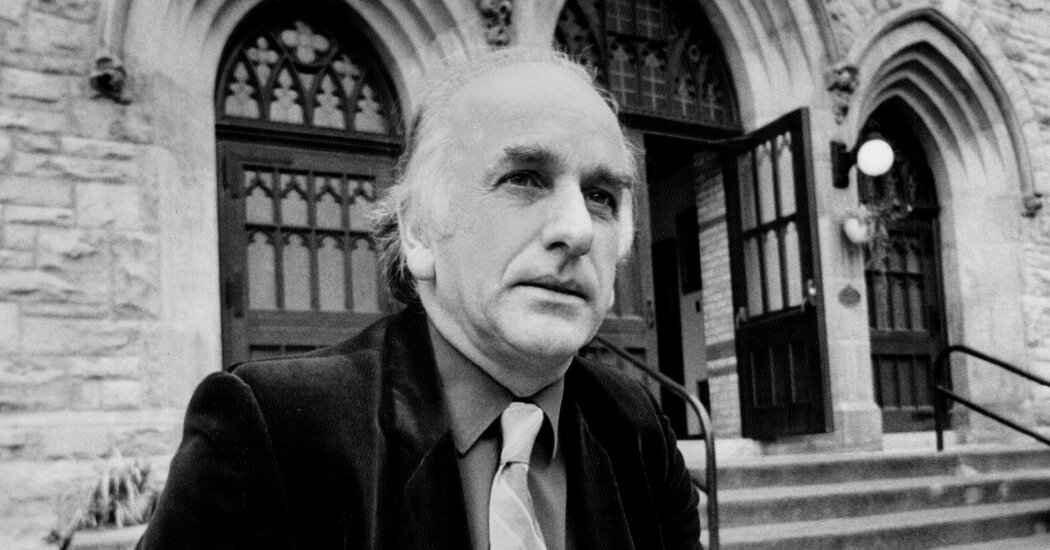Derek Humphry, a British-born journalist whose experience helping his terminally ill wife end her life led him to become a crusading pioneer in the right-to-die movement and to publish “Final Exit,” a best-selling guide to suicide, died on Jan. 2 in Eugene, Ore. He was 94.
His death, at a hospice facility, was announced by his family.
With a populist flair and a knack for speaking matter-of-factly about death, Mr. Humphry almost single-handedly galvanized a national conversation about physician-assisted suicide in the early 1980s, at a time when the idea had been little more than an esoteric theory batted around by medical ethicists.
“He was the one who really put this cause on the map in America,” said Ian Dowbiggin, a professor at the University of Prince Edward Island and the author of “A Concise History of Euthanasia: Life, Death, God, and Medicine” (2005). “The people who support the notion of physician-assisted suicide absolutely owe him a big thanks.”
In 1975, Mr. Humphry was working as a reporter for The Sunday Times of London when Jean Humphry, his wife of 22 years, was in the final stages of terminal bone cancer. Hoping to avoid prolonged suffering, she asked him to help her die.
Mr. Humphry procured a lethal dose of painkillers from a sympathetic doctor and mixed them with coffee in her favorite mug.
“I took her the mug and told her if she drank it she’d die immediately,” Mr. Humphry told The Daily Record of Scotland. “Then I gave her a hug, kissed her and we said our goodbyes.”
Mr. Humphry chronicled the emotional, taboo and legally fraught pursuit of his wife’s hastened death in the book “Jean’s Way” (1979). Excerpted in newspapers around the world, it was a sensation. Readers sent letters to the editor discussing the suffering of their loved ones. Many wrote directly to Mr. Humphry.
“I wish we had a solution like yours,” a woman wrote, describing her husband’s last eight weeks of life as “a horror.” “How much more beautiful, how much more ‘love.’ We did what others forced us to do and experienced that dreadful ‘death’ the medical world gives by prolonging life in every possible way.”
In their letters, some readers pleaded for instructions to help their loved ones die. That prompted Mr. Humphry, by then remarried and working in California for The Los Angeles Times, to think about creating an organization to advocate for assisted suicide and end-of-life rights for the terminally ill.
Ann Wickett Humphry, his second wife, suggested using the word Hemlock as a title for the organization, “arguing that most Americans associate the word with the death of Socrates, a man who discussed and planned his death,” Mr. Humphry later wrote in an updated edition of “Jean’s Way.”
In August 1980, he and his wife rented the Los Angeles Press Club to announce the establishment of the Hemlock Society, which they ran out of the garage of their home in Santa Monica.
The organization grew quickly. In 1981, it issued “Let Me Die Before I Wake,” a guide to medicines and dosages for inducing “peaceful self-deliverance.” The group also lobbied state legislatures to enact laws making assisted suicide legal. In 1990, the Hemlock Society moved to Eugene. By then it had more than 30,000 members, but the right-to-die conversation hadn’t yet reached most dinner tables in America.
That changed spectacularly in 1991, after Mr. Humphry published “Final Exit: The Practicalities of Self-Deliverance and Assisted Suicide for the Dying.” The book was a 192-page step-by-step guide that, in addition to explaining suicide methods, provided Miss Manners-like tips for exiting gracefully.
“If you are unfortunately obliged to end your life in a hospital or motel,” he wrote, “it is gracious to leave a note apologizing for the shock and inconvenience to the staff. I have also heard of an individual leaving a generous tip to a motel staff.”
“Final Exit” quickly shot to No. 1 in the hardcover advice category of The New York Times’s best-seller list.
“That is an indication of how large the issue of euthanasia looms in our society now,” the bioethicist Dr. Arthur Caplan told The Times in 1991. “It is frightening and disturbing, and that kind of sales figure is a shot across the bow. It is the loudest statement of protest of how medicine is dealing with terminal illness and dying.”
Reactions to “Final Exit” were generally divided along ideological lines. Conservatives blasted it.
“What can one say about this new ‘book’? In one word: evil,” the University of Chicago bioethicist Leon R. Kass wrote in Commentary magazine, calling Mr. Humphry “the Lord High Executioner.” “I did not want to read it, I do not want you to read it. It should never have been written, and it does not deserve to be dignified with a review, let alone an article.”
But progressives embraced the book, even as public health experts expressed concern that the methods it laid out could be used by depressed people who weren’t terminally ill.
“I’ve read ‘Final Exit’ out of curiosity, but I’ll keep it for another reason — because I can imagine, having once nursed a cancer patient, the day when I might want to use it,” the New York Times columnist Anna Quindlen wrote. She added, “And if that day comes, whose business is it, really, but my own and that of those I love?”
Rather than worrying about the book’s contents, Ms. Quindlen said, “we should look for ways to insure that dignified death is available in places other than the chain bookstore at the mall.”
Derek John Humphry was born on April 29, 1930, in Bath, England. His father, Royston Martin Humphry, was a traveling salesman. His mother, Bettine (Duggan) Humphry, had been a fashion model before marrying.
After leaving school at age 15, Derek got a job as a newspaper messenger. The next year, The Bristol Evening World hired him as a reporter. He went on to report for The Manchester Evening News and The Daily Mail before moving to The Sunday Times of London and then to The Los Angeles Times.
Before turning to books about death, Mr. Humphry wrote “Because They’re Black” (1971), an examination of racial discrimination written with Gus John, a Black social worker, and “Police Power and Black People” (1972), about racism and corruption in Scotland Yard.
Mr. Humphry was a polarizing figure even within the right-to-die movement.
In 1990, he and Ms. Wickett Humphry divorced and fought bitterly in the news media. She called him a “fraud,” accusing him of leaving her because she had been diagnosed with cancer. Mr. Humphry denied the allegation.
“This was a very shaky marriage,” he told The New York Times in 1990. “This is extremely painful, as bad as Jean’s death. I’ve lost my home; I’ve lived in a motel for three months.”
Ms. Wickett Humphry killed herself in October 1991.
In a video recorded the day before, she expressed misgivings about the work they had done together, including helping her parents end their lives at home.
“I walked away from that house thinking we’re both murderers,” she said in the video, which was reviewed by The Times.
Mr. Humphry went into “damage control” mode, he told The Times. He placed a half-page advertisement in the paper explaining his side of the story.
“Sadly, for much of her life Ann was dogged by emotional problems,” the advertisement said, adding that “suicide for reasons of depression has never been part of the credo of the Hemlock.”
Ms. Wickett Humphry’s death and reservations about the right-to-die movement caused strain within the Hemlock Society. Mr. Humphry resigned as executive director in 1992 and started the Euthanasia Research and Guidance Organization.
The Hemlock Society eventually splintered into several new groups, including the Final Exit Network, which Mr. Humphry helped start.
He married Gretchen Crocker in 1991. She survives him, along with three sons from his first marriage; three grandchildren; and one great-grandchild.
Lowrey Brown, a Final Exit Network “exit guide” who helps terminally ill patients plan their deaths, said in an interview that her clients sometimes credit Mr. Humphry and “Final Exit” for giving them the courage to end their lives.
“It was the Hemlock Society and the book ‘Final Exit’ that really crossed the threshold of getting this into ordinary Americans’ living rooms as a discussion topic,” Ms. Brown said. “You could talk about it at the Thanksgiving dinner table.”
If you are having thoughts of suicide, call or text 988 to reach the Suicide and Crisis Lifeline or go to SpeakingOfSuicide.com/resources for a list of additional resources.


